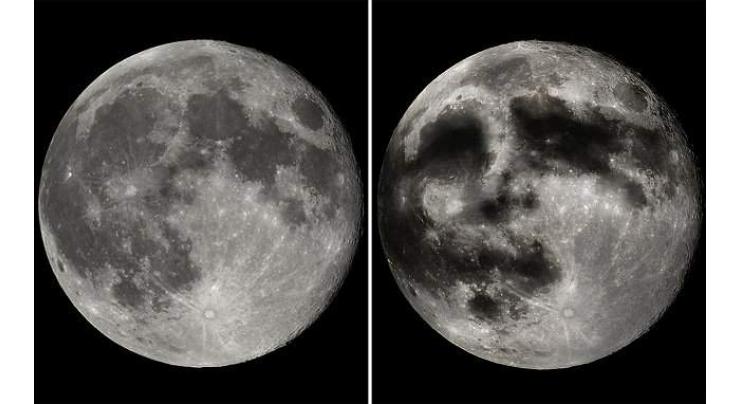
The 'man In The Moon' Illusion Is Caused By Lunar Swirls, New Study Finds
Mohammad Ali (@ChaudhryMAli88) Published September 12, 2018 | 06:10 PM

"When you look up at a bright full moon on a clear night, you may wonder at the appearance of a human face on the moon's surface."
New Jersey, (UrduPoint / Pakistan Point News - 12th Sep, 2018 ) :"When you look up at a bright full moon on a clear night, you may wonder at the appearance of a human face on the moon's surface."This illusion is often referred to as the man in the moon and is defined by the light and dark parts of the lunar facade. In some ancient myths, the face is that of a man who was banished to the moon for committing a crime.
But what is the science behind the moon seemingly conveying the appearance of a human face? According to a new study, published in the Journal of Geophysical Research, it's down to 40-mile-long lunar swirls created by magnetic lava flows beneath the moon's surface. These swirls cause patterns and shapes to materialise on the rocky satellite.
Lunar swirls are collections of finely structured, bright and dark surface markings, alternating over length scales of typically 15 km, the study states. Swirls are thought to form where local magnetic fields shield parts of the lunar surface from exposure to the solar wind or where those magnetic fields lead to sorting of some of the finest lunar soils.
These swirls are not a new discovery as NASA has been aware of them for decades and recorded the Reiner Gamma swirl with the Lunar Reconnaissance Orbiter.
But this is the first time conclusions have been drawn about what causes them.
The recent research, conducted by scientists at Rutgers University and the University of California, Berkeley, mapped the lunar swirls with the use of computer models.
Narrow magnetic zones are where these swirls were found to occur and are linked to ancient underground tunnels called lava tubes. These extremely magnetic areas are connected to the strong volcanic activity of the moon's past and deflect particles within solar winds, resulting in certain areas of the moon staying dark.
These magnetised rocks were likely injected into the crust in the form of dikes or subsurface channels of flowing lava and that they cooled slowly, leading to enhancement of their metal content and enabling the rocks to capture a stable record of the Moon's ancient global magnetic field, the study authors wrote.
The lunar swirls creating contrasting light and dark areas of the moon may now explain thereason we interpret a human face in the moon.
Recent Stories

Tennis: ATP Barcelona Open results - 1st update

Swiatek's perfect 10 in Stuttgart as Vondrousova stuns Sabalenka

Arandu's roads closed due to flooding

Oil tanker catches fire in Islamabad’s Blue Area

Pakistan committed to ensure safety of foreign nationals: FO

Tennis: WTA Stuttgart results - 1st update

Four passengers injured as train hit an empty vehicle

Over- speeding bus crushed to death two bike riders

Turkey's Freedom Flotilla ready to set sail for Gaza

French teen dies from heart failure after knife attack near school

Iranians appear unfazed by Isfahan blasts

UAF celebrates Int'l Chinese Language Day
More Stories From Science
-

China's Mars rover finds water evidence on the red planet: study
2 years ago -

China's top 10 advances in life sciences in 2021 unveiled
2 years ago -

Not quite $1: US chain Dollar Tree announces price hike
2 years ago -

Australian astronomers help solve galaxy "murder mystery"
2 years ago -

US-European Solar Orbiter Spacecraft Makes Venus Flyby - ESA
3 years ago -

Chinese scientists discover ultrahigh-energy cosmic accelerators in Milky Way
3 years ago
-

Universe becomes hotter over billions of years
3 years ago -

Researchers discover high-speed jet closest to black hole
4 years ago -
Scientists find gas on Venus linked to life on Earth
4 years ago -

Scientists find 'life harbouring' gas on Venus
4 years ago -

Scientists find way to track space junk in daylight
4 years ago -
Solar Orbiter gives scientists unprecedented look at Sun
4 years ago









